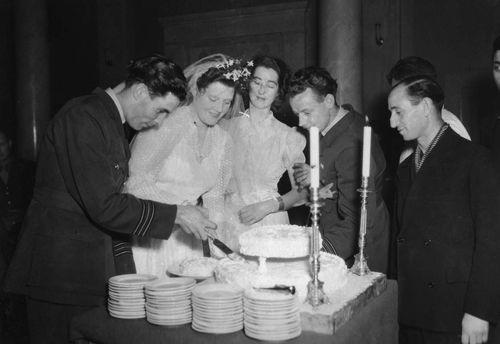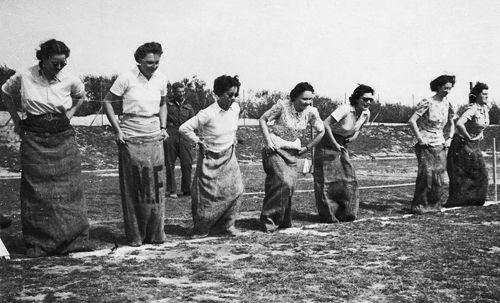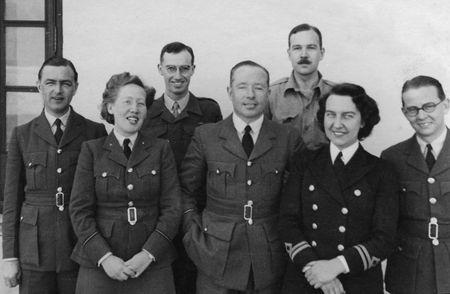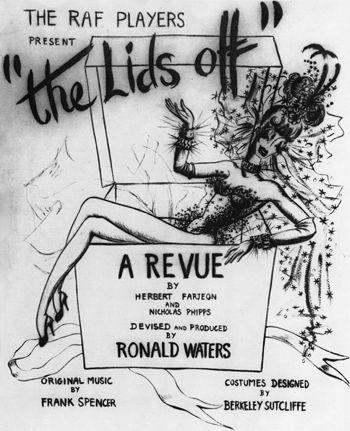Women of Intelligence: Winning the Second World War with Air Photos (36 page)
Read Women of Intelligence: Winning the Second World War with Air Photos Online
Authors: Christine Halsall

A few months later, on 4th June 1944, my husband was responsible for taking some very important photographs, the day that Rome fell to the Allies, after heavy bombing. He flew the reconnaissance sortie twenty minutes after the bombing to prove to the world that the Allies had not destroyed the ancient sites in the city.

In February 1944, Section Officer Suzie Morrison married Squadron Leader Jimmy Morgan in the opera house at San Severo. He was the commanding officer of 682 PR Squadron and the wedding cake was suitably adorned with a model Spitfire.
As the Allies advanced northwards, some of the PIs moved from Cairo to San Severo, including Dorothy Colles, who often disappeared into the countryside with her painting gear and produced enough pictures for an exhibition in London after the war. Dorothy Lygon, ‘Coote’, was able to spend some time visiting Evelyn Waugh, the novelist, in hospital in the nearby town of Bari. Waugh had been badly burned in a plane crash while on an assignment with Randolph Churchill to make contact with the partisans in Yugoslavia. ‘Coote’ had been one of Waugh’s closest friends since his first visit to her family home of Madresfield in 1931. When he was sent to Rome to convalesce, she spent her leave there looking after him.
7
The following extract from a captured German Divisional Order dated July 1944, and subsequently published in the British Eighth Army news bulletin, confirmed the effectiveness of the reconnaissance and interpretation work carried out by the Mediterranean Allied Photographic Reconnaissance Wing:
Enemy Aerial Reconnaissance detects our every movement, every concentration, every weapon, and immediately after detection smashes every one of these objectives.
In January 1942, Wing Commander Glyn Daniel, the Cambridge archaeologist, was posted to India. His instructions were to organise PI training for as many army and RAF officers as possible and to set up an interpretation unit, based on the Medmenham model, to work with PR squadrons flying reconnaissance cover in support of British troops fighting the Japanese in Burma. The unit became the Command Photographic Interpretation Centre (CPIC), the HQ for PI in preparation for defeating the Japanese once the war in Europe was won. In February 1942 Singapore was overrun by Japanese forces and surrendered, causing several PIs who were in transit to the Far East to divert to India and form the nucleus of instructors. CPIC had truly palatial buildings to work in as they were allotted Hyderabad Palace, the Delhi residence of the Nizam of Hyderabad, which housed all the Far East Third-Phase sections, a Model-Making Section, and a PI school.

The start of the WAAF sack race at San Severo. From left: ‘Coote’, Honor Clements, Peggy Thorpe, Lothian Nicholas, Angus Wilson, Celia McDonald and Suzie Morrison.
Early in 1945, WAAF personnel were posted to work in India as part of the shift of emphasis from the European theatre of war to that in south-east Asia. They had quite an effect on their male counterparts as Glyn Daniel recalled:
The WAAF other ranks arrived first and naturally caused a big stir among the airmen. Within a week of their arrival one of my sergeant photographers came to see me and asked for permission to marry one of them. She was a very nice girl but I counselled a short delay to which they agreed, and after a month I gave her away in St James’s church in Delhi.
Then the WAAF officers arrived and people began going down like ninepins. I posted one WAAF officer, Elspeth Macalister, who had read archaeology at Cambridge, to ‘Trader’ Horne’s office: he had complained for some time of being overworked. A shy man, he immediately moved his desk out onto a draughty veranda, but in a few weeks they were engaged to be married. I proposed their health at their marriage back in Cambridge after the war.
8
What Elspeth did not know at that time was that ‘Trader’ had asked Glyn specifically that no WAAF should be posted to his section, as they would disrupt the work.
In December 1944, Elspeth and five PI colleagues had set sail from Liverpool to Bombay, followed by a three-day train journey to Delhi, giving the WAAFs their first sight of India:
Small villages, wells, simple ploughing with camels or oxen, women in brightly coloured garments complemented by luminous peacocks. We stopped at numerous stations and at meal times disembarked to be fed at the station café. At night when the train stopped at a station, brown arms would stretch towards the windows of our carriage to see if anything could be purloined. Eve Holiday lost her uniform as she had hung it rather conspicuously on a dodgy hanger. As her other uniform was in her trunk in the guard’s van, she had to arrive in Delhi in her WAAF striped pyjamas!
We had all served for several years at Medmenham in different sections; plotting, communications, Second Phase and bomb damage. At CPIC I was allocated to the Shipping Section. The head of this Section was a handsome Army officer, Capt JET Horne; the staff consisted of two naval officers, five RAF officers and me.
9
The Shipping Section produced reports on the Japanese navy and Malayan port installations in preparation for Operation Zipper, the planned invasion of Malaya, which would be the prelude to the defeat of Japan. One of Elspeth’s tasks was to make a mosaic, a detailed map made of runs of photographs, of the Mekong River at Bangkok.
Although it took rather more than the ‘few weeks’ claimed by Glyn Daniel for Elspeth and ‘Trader’ to become engaged, before long they were spending their days off together, exploring Delhi on their bikes and enjoying dinners at the Imperial Hotel. Later on they visited Jaipur and Kashmir together:
Of course in those days it was not done for single girls to go off with single men. It was assumed they would, of course, sleep together. I had a letter from Mum forbidding me to go and Trader’s mother kept it very dark. We took no notice and went ahead with our plans.

Elspeth Macalister WAAF (left) and Christine Guthrie WRNS arrived in Delhi in 1945 where it was cold enough to wear blue uniform. ‘Trader’ Horne is second from left, back row.
And sure enough, they were ‘cut’ and snubbed by Europeans making just that assumption on all their travels. When the war ended, so did their journeys, and ‘Trader’ returned to be demobilised in Britain, but that was not the end of their story.
Glyn Daniel himself was not immune to the WAAF effect on CPIC, for he also met his future wife in Delhi. Ruth Langhorne had read geography at Oxford University and worked in the Industry Section at Medmenham before travelling to India. Her first meeting with Glyn had, in fact, been earlier at Medmenham when he lectured to WAAFs on CPIC, and Ruth had been unimpressed by ‘a slightly bland man playing down the difficulties of life in India’. However, she did volunteer for India as travel at government expense seemed too good an opportunity to miss, and before long she and Glyn were planning their own wedding. With the Japanese surrender in August 1945, Glyn, like ‘Trader’, found himself unexpectedly heading back to civilian employment in England, while Ruth stayed on in Delhi for another six months as commanding officer CPIC.
Ann McKnight-Kauffer had spent some time in the Night Photography Section at Medmenham learning about H
2
S, a navigational aid using radar in the aircraft, and went to India to promote its use and interpret any photographs obtained. She lectured first in Delhi and was then detached to Calcutta, but could not create much interest for the system among the British, although the Americans were more enthusiastic. Ann also flew to Ceylon (now Sri Lanka) and wrote:
I was flown from Dum Dum (Calcutta’s airfield) via Vizagpatam and Bangalore to Raturalana, near Columbo. It was a long and bumpy journey through the monsoon, but made immortal by the view northwards up the toe of India from over the islands at sunset.
From Raturalana I went by car to Columbo and thence in Lord Louis Mountbatten’s (Allied Supreme Commander in South East Asia) conference train up the dark mountain way to Kandy (the location of Air Headquarters). Dinner of bacon and eggs was served on the train and of all the strange coincidences I found myself hailed by Tommy Tilling of ‘K’ Section from Medmenham who joined me for the feast. I think he was a little surprised that I was being summoned to Kandy and so was I!
10

CPIC in Delhi also had a thriving theatre group as this poster for a revue illustrates.
Eve Holiday had been in First Phase at RAF Benson and went to work in First and Second Phase at 347 (Reconnaissance) Wing at Bally, near Calcutta, where she became the senior WAAF PI:
The interpretation was very different from Benson, and although we had been briefed a bit in Delhi we had to learn as we went along. Most of the cover was over jungles and rivers, and a sort of ‘Guerrilla Warfare Interpretation’ was needed. You had to watch for elementary signs of human habitation – trees being cleared, track activity, smoke from fires. I remember searching sortie after sortie for smoke.
The Japanese, knowing that the Allies would avoid upsetting locals by attacking temples, habitually used them as ammunition dumps; so you had to watch the track activity very carefully. The normal worshippers used straight, well established paths to the temple, whereas the Japanese soldiers cut corners with consequent track activity. On the rivers, sampans were often used as gun positions, and we got to know when they were converted.
11